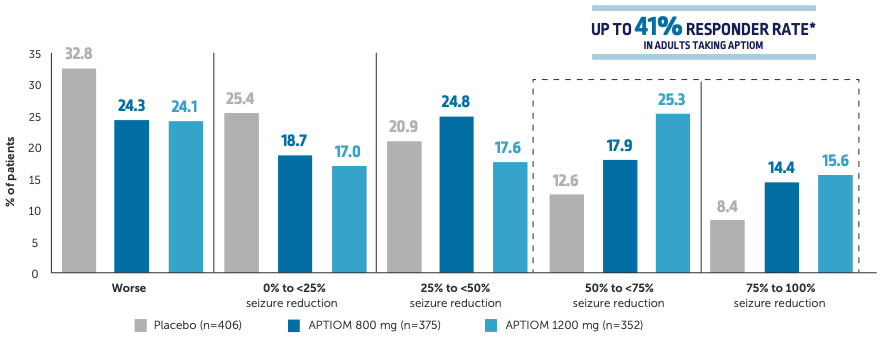EFFICACY ACHIEVED across multiple clinical trials
The efficacy of APTIOM as adjunctive therapy in focal seizures was established in 3 randomized, double-blind, placebo-controlled, multicenter trials in adult patients.1
APTIOM was also proven effective in monotherapy trials.1

Actor Portrayals
Up to 4 in 10 patients had a 50% or greater reduction in seizures across all 3 adult adjunctive pivotal trials2
Secondary endpoint:
Proportion of patients by category of seizure reduction across all 3 double-blind adjunctive studies (pooled).3
PERCENTAGE OF PATIENTS BY CATEGORY OF SEIZURE REDUCTION1,2

*Response was defined as ≥50% reduction in standardized seizure frequency. Patients in APTIOM adult adjunctive therapy clinical studies experienced a range of treatment effects, from no response (an increase from baseline in seizure frequency to a modest reduction from baseline in seizure frequency) to a 100% reduction from baseline in seizure frequency.1,2
Primary endpoint
APTIOM showed reduced 4-week standardized seizure frequency during 12 weeks of maintenance therapy vs placebo (P<0.05). A statistically significant effect was observed with APTIOM 800 mg in Studies 3 and 4 (Study 5; P=0.058) and with APTIOM 1200 mg in all 3 studies.1
Secondary endpoints
- Responder rate–In the Phase III adjunctive pivotal trials, up to 41% of APTIOM-treated patients had a ≥50% responder rate compared to 21% in placebo-treated patients. APTIOM 800 mg (P=0.0003), APTIOM 1200 mg (P<0.0001)4
Patients taking APTIOM tend to stay on APTIOM
APTIOM demonstrated retention to therapy in multiple studies
Robust Completion Rates In Phase III Trials
Completion rate in Phase III
adjunctive pivotal trials when prescribed at 800 mg3
Completion rate in Phase III
adjunctive pivotal trials when prescribed at 1200 mg3
82%
71%
Following a 2-week titration phase, patients remained on a stable dose of APTIOM or placebo for a 12-week maintenance phase.3
Completion rate in Phase III
monotherapy trials when prescribed at 1200 mg for the 10-week monotherapy phase4
Completion rate in Phase III
monotherapy trials when prescribed at 1600 mg for the 10-week monotherapy phase4
75%
86%
Following a 2-week titration phase, baseline ASMs were gradually tapered over a 6-week withdrawal phase. Patients remained on a stable dose of APTIOM 1600 mg or 1200 mg for a 10-week monotherapy phase.1
Effective ASM therapy for pediatric patients 4 to 17 years of age1
The safety and effectiveness of APTIOM have been established in pediatric patients 4 to 17 years of age*
Use of APTIOM in this age group is supported by:
- Evidence from adequate and well-controlled studies of APTIOM in adult patients with focal seizures
- Pharmacokinetic data from adult and pediatric patients
- Safety data from clinical studies in 393 pediatric patients 4 to 17 years of age
*Safety and effectiveness in patients below 4 years of age have not been established.
Up to 4 in 10 patients had a 50% or greater reduction in seizures across all 3 adult adjunctive pivotal trials2
Secondary endpoint:
Proportion of patients by category of seizure reduction across all 3 double-blind adjunctive studies (pooled).3
PERCENTAGE OF PATIENTS BY CATEGORY OF SEIZURE REDUCTION1,2

*Response was defined as ≥50% reduction in standardized seizure frequency. Patients in APTIOM adult adjunctive therapy clinical studies experienced a range of treatment effects, from no response (an increase from baseline in seizure frequency to a modest reduction from baseline in seizure frequency) to a 100% reduction from baseline in seizure frequency.1,4
Primary endpoint
APTIOM showed reduced 4-week standardized seizure frequency during 12 weeks of maintenance therapy vs placebo (P<0.05). A statistically significant effect was observed with APTIOM 800 mg in Studies 3 and 4 (Study 5; P=0.058) and with APTIOM 1200 mg in all 3 studies.1
Secondary endpoints
- Responder rate–In the Phase III adjunctive pivotal trials, up to 41% of APTIOM-treated patients had a ≥50% responder rate compared to 21% in placebo-treated patients. APTIOM 800 mg (P=0.0003), APTIOM 1200 mg (P<0.0001)4
Patients taking APTIOM
tend to stay on APTIOM
APTIOM demonstrated retention to therapy in multiple studies
ROBUST COMPLETION RATES IN
PHASE III TRIALS
Completion rate in Phase III
adjunctive pivotal trials when prescribed at 800 mg3
Completion rate in Phase III
adjunctive pivotal trials when prescribed at 1200 mg3
Following a 2-week titration phase, patients remained on a stable dose of APTIOM or placebo for a 12-week maintenance phase.3
Completion rate in Phase III
monotherapy trials when prescribed at 1200 mg for the 10-week monotherapy phase4
Completion rate in Phase III
monotherapy trials when prescribed at 1600 mg for the 10-week monotherapy phase4
Following a 2-week titration phase, baseline ASMs were gradually tapered over a 6-week withdrawal phase. Patients remained on a stable dose of APTIOM 1600 mg or 1200 mg for a 10-week monotherapy phase.1
Effective ASM therapy for pediatric patients 4 to 17 years of age1
The safety and effectiveness of APTIOM have been established in pediatric patients 4 to 17 years of age*
Use of APTIOM in this age group is supported by:
- Evidence from adequate and well-controlled studies of APTIOM in adult patients with focal seizures
- Pharmacokinetic data from adult and pediatric patients
- Safety data from clinical studies in 393 pediatric patients 4 to 17 years of age
*Safety and effectiveness in patients below 4 years of age have not been established.